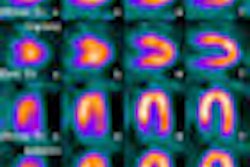While SPECT has proved beneficial in detecting lesions in bone scans, researchers at the Mount Sinai School of Medicine in New York City have found that SPECT/CT is even more advantageous in determining exact lesion location.
The researchers investigated the efficacy of SPECT/CT in evaluating back pain patients and the modality's value in the workup of those patients. The study is an extension of previous work by co-author Dr. Sherif Heiba in Mount Sinai's division of nuclear medicine.
The retrospective study evaluated 114 patients with back pain. Forty-five men and 69 women with a mean age of 60 years underwent planar imaging and SPECT/CT. Planar, SPECT, and SPECT/CT were separately reviewed by two observers who noted lesion presence, location, and a specific diagnosis for each scan.
Confidence factors
The readers then rated their confidence in the scans as uncertain, probable, or certain. In addition, CT findings in 38 back pain patients with 80 lesions evaluated by SPECT/CT were further categorized as supportive or not supportive of SPECT/CT diagnosis.
Final diagnosis was confirmed by surgical, pathological, or radiological confirmation, or by 25-month follow-up. There were 240 lesions detected in 114 back pain patients with final diagnoses of arthritis, degenerative disease, fracture, postoperative changes, and normal bone scan.
Of the 114 patients, the planar scan discovered 173 lesions, SPECT detected 219 lesions, and SPECT/CT showed 224 lesions. "We found that diagnosis was established as a fracture in 35 patients, postop changes in four patients, degenerative changes in 28 patients, and as normal scans in 17 patients," said Heiba in his presentation at the 2008 SNM meeting in New Orleans.
In researchers' comparison of lesion location confidence between SPECT and SPECT/CT, there were 50 patients with uncertain lesion location. Of the 50 cases, SPECT determined 42 probable and six certain lesion locations, compared with SPECT/CT, which determined 48 patients with certain lesions.
SPECT/CT's superiority
SPECT/CT also outperformed SPECT among 94 patients with probable planar lesion locations. SPECT showed 42 locations as certain, while SPECT/CT was able to conclude 87 certain locations.
As to the certainty of lesion locations, for 14 patients who were categorized as uncertain, SPECT upgraded the interpretation to 10 certain lesions, with SPECT/CT confirming 12 cases as certain. Of 60 probable lesions, there were 55 certain lesions determined by SPECT and 57 by SPECT/CT, which Heiba described as "not significantly different."
On the evaluation of diagnostic certainty of the back pain patients, of 68 uncertain lesions, 44 probable lesions were discovered with diagnostic certainty with SPECT, compared with 53 certain lesions for SPECT/CT.
The study also noted that SPECT/CT was more predictive of final diagnosis than SPECT alone, as assessed by Lambia value (0.96 versus 0.83, respectively) and uncertainty coefficient error reduction (92% versus 73%, respectively).
"While the detection of bone scan lesions is significantly improved by SPECT, hybrid SPECT/CT can additionally clarify the exact location of these lesions," Heiba concluded. "Lesion localization appears to be most predictive with the superiority of SPECT/CT's diagnostic confidence in patients with back pain."
By Wayne Forrest
AuntMinnie.com staff writer
September 18, 2008
Related Reading
SPECT/CT offers better bone scan views to enhance treatment, September 21, 2007
SPECT/CT offers on-target diagnosis in noncancerous bone disease, March 23, 2007
Scintigraphy pegs potential responders to plantar fasciitis treatment, October 25, 2006
Experimental CAD scheme makes quick work of bone scintigraphy analysis, June 5, 2006
Bone SPECT identifies patients who would benefit from facet joint injection, February 15, 2006
Copyright © 2008 AuntMinnie.com




















